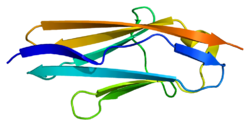

| SPEG | |||||||||||||||||||||||||||||||||||||||||||||||||||
|---|---|---|---|---|---|---|---|---|---|---|---|---|---|---|---|---|---|---|---|---|---|---|---|---|---|---|---|---|---|---|---|---|---|---|---|---|---|---|---|---|---|---|---|---|---|---|---|---|---|---|---|
 | |||||||||||||||||||||||||||||||||||||||||||||||||||
| |||||||||||||||||||||||||||||||||||||||||||||||||||
| Identifiers | |||||||||||||||||||||||||||||||||||||||||||||||||||
| Aliases | SPEG, APEG-1, APEG1, BPEG, SPEGalpha, SPEGbeta, CNM5, SPEG complex locus, MYLK6, striated muscle enriched protein kinase | ||||||||||||||||||||||||||||||||||||||||||||||||||
| External IDs | OMIM: 615950; MGI: 109282; HomoloGene: 55619; GeneCards: SPEG; OMA:SPEG - orthologs | ||||||||||||||||||||||||||||||||||||||||||||||||||
| |||||||||||||||||||||||||||||||||||||||||||||||||||
| |||||||||||||||||||||||||||||||||||||||||||||||||||
| |||||||||||||||||||||||||||||||||||||||||||||||||||
| |||||||||||||||||||||||||||||||||||||||||||||||||||
| |||||||||||||||||||||||||||||||||||||||||||||||||||
| Wikidata | |||||||||||||||||||||||||||||||||||||||||||||||||||
| |||||||||||||||||||||||||||||||||||||||||||||||||||
Striated muscle preferentially expressed protein kinase, in the human is encoded by the SPEG gene, a member of the myosin light chain kinase protein family.[5][6][7] SPEG is involved in the development of the muscle cell cytoskeleton,[5] and the expression of this gene has important roles in the development of skeletal muscles, and their maintenance and function.[7] Mutations are associated with centronuclear myopathies a group of congenital disorders where the cell nuclei are abnormally centrally placed.[8]
In the mouse this gene is called SPEG complex locus.[9] Expression of this gene is thought to serve as a marker for differentiated vascular smooth muscle cells which may have a role in regulating growth and differentiation of this cell type. The encoded protein is highly similar to the corresponding rat and mouse proteins. Multiple alternatively spliced transcript variants have been found for this gene, but the full-length nature of only one variant has been defined.
| Mouse Mutant Alleles for Speg | ||
|---|---|---|
| Marker Symbol for Mouse Gene. This symbol is assigned to the genomic locus by the MGI | Speg | |
| Mutant Mouse Embryonic Stem Cell Clones. These are the known targeted mutations for this gene in a mouse. | Spegtm1a(KOMP)Wtsi | |
| Example structure of targeted conditional mutant allele for this gene | ||
 | ||
| These Mutant ES Cells can be studied directly or used to generate mice with this gene knocked out. Study of these mice can shed light on the function of Speg:
see Knockout mouse | ||
|
| |
|---|---|
| Activity |
|
| Regulation |
|
| Classification |
|
| Kinetics |
|
| Types |
|
This protein-related article is a stub. You can help Wikipedia by expanding it. |